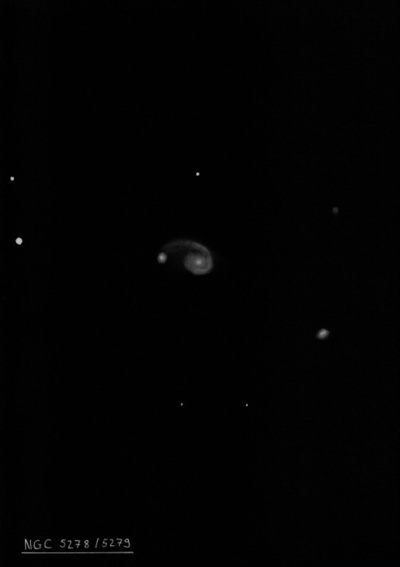
William Herschel discovered NGC 5278 = H II-798 = h1665 on 14 Apr 1789 (sweep 921) and noted "pB, E, 1 1/2' long and 1/2' br." His position is 2' northwest of this double system. JH resolved it and recorded "vF; double neb; pos = 73° by microm; a large star follows dist = 15' +/-." The field was sketched on 9 Apr 1874 at Birr Castle and a "star" labeled "epsilon" actually corresponds with UGC 8671.
400/500mm - 17.5" (6/18/93): fairly faint, fairly small, round, 45" diameter, very weakly concentrated core. Forms a double system with NGC 5279 just off the ENE edge 40" between centers. A mag 13.5 star lies 1.7' NNW. Located 8.1' WSW of mag 6.9 SAO 28858.
600/800mm - 24" (6/21/20): at 375x; moderately bright, fairly small, oval 4:3 WSW-ENE, ~36"x27", brighter elongated core. I saw of hint of the spiral arm on the north side, but no indication of the bridge connecting to NGC 5279.
UGC 8671, located 2.7' SW, was dominated by a 13th magnitude quasi-stellar nucleus. The halo was barely detected as a very diffuse, low surface brightness glow mainly west of the nucleus.
900/1200mm - 48" (5/3/19): at 545x and 813x; bright, fairly small, slightly elongated, bright core. This is an interacting (Arp 239 = VV 19) one-armed spiral with a diffuse bridge to NGC 5279 0.6' ENE of center. The single arm wraps tightly around the south side to the west and then separates on the north side. There was a brightening along the south edge that gave the impression of an arm, though it hugged the core too tightly to be resolved. But starting on the west side a straight spiral arm was evident extending NE. The arm dimmed suddenly into low surface brightness haze that extended further east to the north side of NGC 5279, merging with its northern spiral arm. The pair is located 8' SW of mag 6.9 HD 119549.
MCG +09-22-094, located 2.8' WNW, appeared fairly faint, fairly small, very thin edge-on ~6:1 N-S, ~0.6'x0.1', low even surface brightness.
UGC 8671, located 2.7' SW, appeared bright, fairly small, slightly elongated ~E-W, sharply concentrated with an intensely bright core!
AGC 1783, with up to 18 ultra-dim IC members observed by Barnard and Burnham, is ~15' ESE.
Notes by Steve Gottlieb